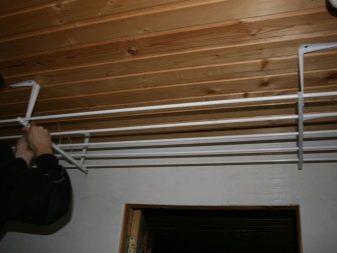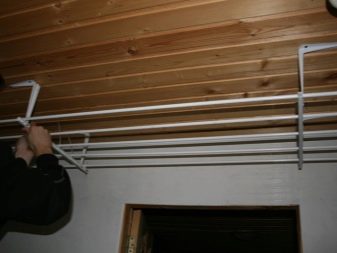Ceiling-mounted laundry dryers in the bathroom

Modern manufacturers of appliances and home accessories offer many options for solving the problem of drying laundry in urban apartments. Therefore, it is becoming rarer and rarer to see sheets and duvet covers flapping in the wind in the yards, and on balconies - slender rows of shirts and socks. It is no longer necessary to stretch clotheslines in secluded corners of the apartment or to dry laundry outside in public view.
The clothes dryer comes in many different variations. The most popular are wall, floor and ceiling designs. In this article, we will talk in detail about dryers for laundry to be mounted on the ceiling: talk about their advantages and disadvantages, give tips on the choice and recommendations for installation.
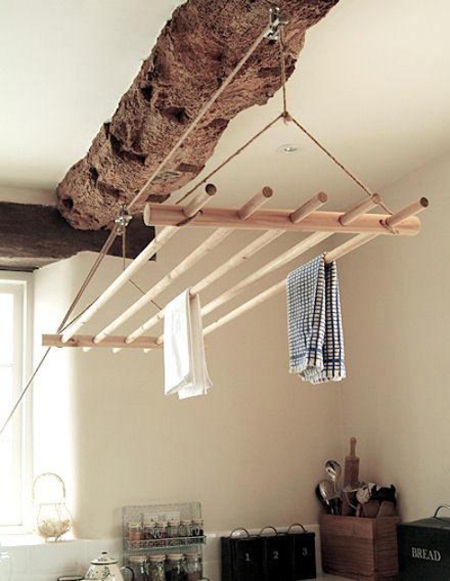
Pros
- Ceiling structures can be adjusted in length, which is very important if your bathroom is small.
- Laundry dryers, which are attached to the ceiling, are some of the most spacious - on them you can dry not only clothing items, but also bed linen, plaids, furniture covers, etc.
- Ceiling models can withstand quite a lot of weight. Depending on the number of holders, such a dryer can accommodate from 5 to 20 kg of washed laundry.
- While space on the floor or walls in the bathroom is not always available, the ceiling is usually not occupied by anything. That's why ceiling-mounted dryers are suitable for the smallest and most cluttered rooms.
- Placed over the bathroom dryer is not conspicuous. And if you still want to hide the laundry from outsiders, just slide the bath curtain.
- It is known that the warm air in the room rises up. Thus, the higher the dryer is, the faster the laundry will dry.
- Ceiling-mounted laundry dryer fixtures are inexpensive.
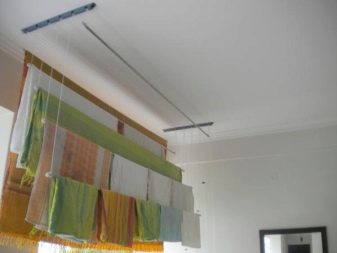
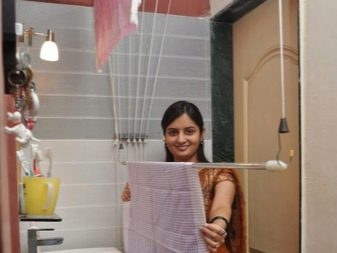
Cons
- The biggest disadvantage of this variety of clothes dryers is the need for installation. If the floor construction is enough to unpack and put in a place of your choice, then with the installation of the ceiling dryer will have to ponder. In addition to the fasteners that come with the device, you will need a drill or punch - to make some holes in the wall.
- The second disadvantage of ceiling clothes dryers is associated with the peculiarities of the material used. Manufacturers offer two options - aluminum and stainless steel. Aluminum designs are cheaper and have less weight, but they are less durable. In addition, such dryers can leave indelible stains on the washed laundry. Laundry dryers made of stainless steel are more durable and completely safe for the laundry, but they cost significantly more.
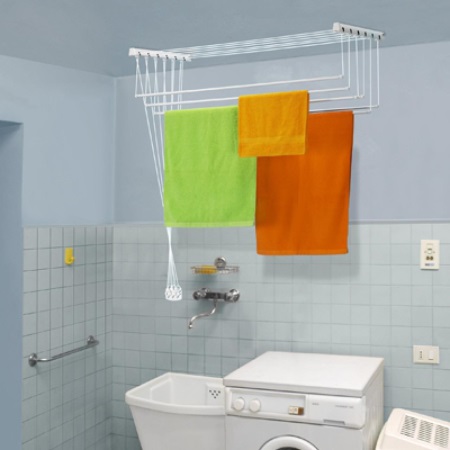
Types
Ceiling dryers are distinguished mainly by the type of construction. Depending on the mechanism, ceiling fixtures for drying laundry can be:
- stationary - dryers, which are traditional rope structures, which are attached to the ceiling with the help of two brackets;
- telescopic - dryers equipped with sliding metal holders that can be adjusted in length;
- sliding - such dryers are also called cantilever or "accordion" dryers, they are attached to the ceiling on folding panels by means of which it is possible to change the height of the device;
- wall-ceiling - the most popular of these models is called "Liana"; it is mounted simultaneously in two planes - on the ceiling and on one wall; such design is very convenient in operation: in order to hang laundry, you can simply lower the holders to the desired level, and then lift them with one easy movement along with the hanging laundry.
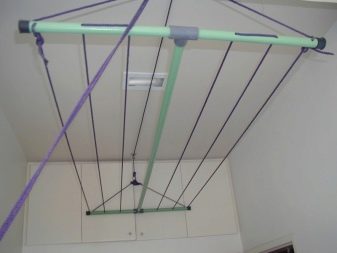
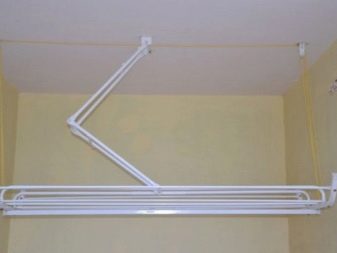
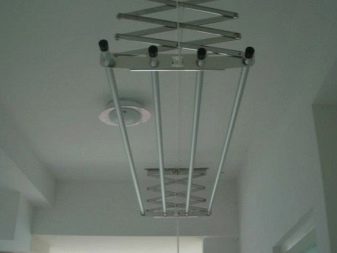
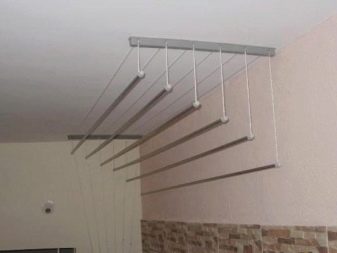
Features
Ceiling-mounted laundry drying devices are most suitable for installation in small bathrooms. Find a place to install such a dryer is not difficult, because usually the ceiling above the bathroom is not occupied by anything, as lighting fixtures are recommended to be placed as far as possible from water sources.
An important factor that should be considered by those who are going to buy a ceiling-mounted clothes dryer is the impossibility of mounting it on a suspended ceiling. Therefore, if your bathroom already has suspended ceilings, you should choose a floor or wall-mounted version of the dryer. If the installation of stretch ceilings is only planned in the future - the installation of a ceiling dryer is possible, but it will be necessary to lay the fastening elements in advance, before the workers start to stretch the canvas.
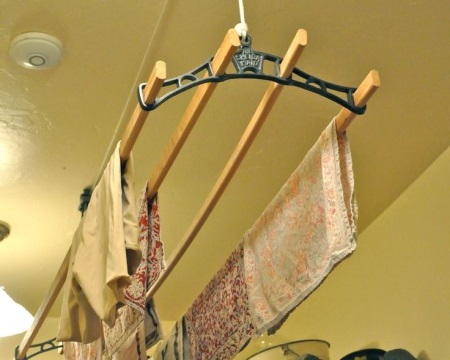
Choosing Tips
On the market of goods for home constantly appear more and more new models of dryers for laundry. Their functionality remains the same, but the production materials and methods of installation change.
When choosing a dryer, focus on the most important parameters:
- the material of manufacture - the strength and durability of the product depends on it;
- construction - it must be chosen on the basis of the specifics of the room and how often you will use the dryer;
- The maximum weight the dryer can bear;
- availability of additional features - such as length and height adjustment, descent and lift mechanism, connection of all laundry holders into one bar for drying heavy or unbendable items, etc.
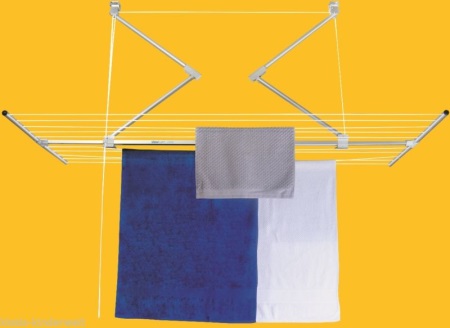
Placement
Modern ceiling clothes dryers can be installed anywhere in the apartment, not just in the bathroom. For example, owners of spacious hallways sometimes prefer to place the dryers there. In any case, the choice of location is conditioned by the peculiarities of the dryer's construction. Thus, wall-ceiling dryers can be installed only in the corner of the room.
When selecting a location for a ceiling-mounted clothes dryer, check whether the hanging laundry will be out of the way when you take a bath or brush your teeth? Does the dryer block access to plumbing fixtures, furniture and doors? Once you have decided on the location, you can begin installation.
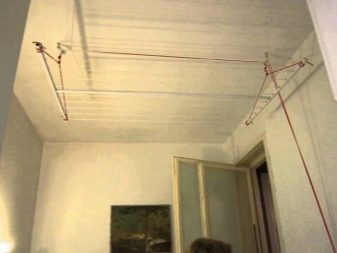
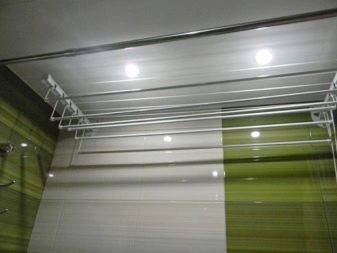
Assembly and installation instructions
Assemble the ceiling dryer for laundry must be in exact accordance with the instructions. Even when buying, you should check the presence and integrity of all parts, including fasteners.
Most models are mounted on brackets, so installation usually begins with fitting brackets to the mounting location and drawing a marking on the wall. Then according to the markings holes are made in the wall, in which plastic fasteners should be inserted. After that assembled dryer is installed on the brackets. The dryer is adjusted after installation by setting the optimum height, length and distance between the brackets.
